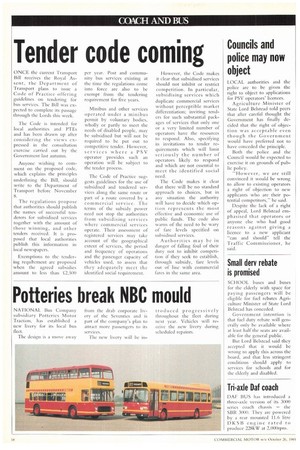Tender code corning
Page 20

If you've noticed an error in this article please click here to report it so we can fix it.
ONCE the current Transport Bill receives the Royal Assent, the Department of Transport plans to issue a Code of Practice offering guidelines on tendering for bus services. The Bill was expected to complete its passage through the Lords this week.
The Code is intended for local authorities and PTEs and has been drawn up after considering the views expressed in the consultation exercise carried out by the Government last autumn.
Anyone wishing to cornmein on the proposed code, which explains the principles underlining the Bill, should write to the Department of Transport before November 8.
The regulations propose that authorities should publish the names of successful tenderers for subsidised services together with the amount of those winning, and other tenders received. It is proposed that local authorities publish this information in local newspapers.
Exemptions to the tendering requPrement are proposed when the agreed subsidies amount to less than i:2,5(1) per year. Post and community bus services existing at the time the regulations conic into force are also to be exempt from the tendering requirement for five years.
Minibus and other services operated under a minibus permit by voluntary bodies, wholly or partly to meet the needs of disabled people, may be subsidised but will not be required to be put out to competitive tender. However, services where a PSV operator provides such an operation will be subject to the tender process.
The Code of Practice suggests guidelines for the usc of subsidised and tendered services along the same route or part of a route covered by a commercial service. The terms of the subsidy power need not stop the authorities from subsidising services where commercial services operate. Their assessment of registered services may take account of the geographical extent of services, the period and frequency of operations and the passenger capacity of vehicles used, to assess that they adequately meet the identified social requirement. However, the Code makes it clear that subsidised services should not inhibit or restrict competition. In particular, subsidising services which duplicate commercial services without perceptible market differentiation; inviting tenders for such substantial packages of services that only one or a very limited number of operators have the resources to respond. Also, specifying in invitations to tender requirements which will limit seriously the number of operators likely to respond and which are not essential to meet the identified social need.
The Code makes it clear that there will be no standard approach to choices, but in any situation the authority will have to decide which option represents the most effective and economic use of public funds. The code also warns of the need to be wary of fare levels specified on subsidised services_ Authorities may be in danger of falling foul of their duty not to inhibit competition if they seek to establish, through subsidy, fare levels out of line with commercial fires in the same area.








































































































